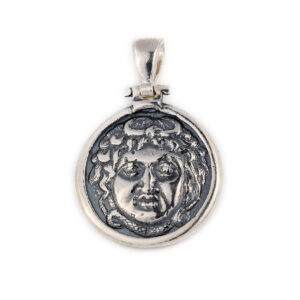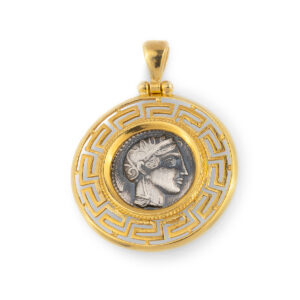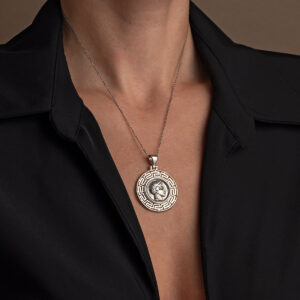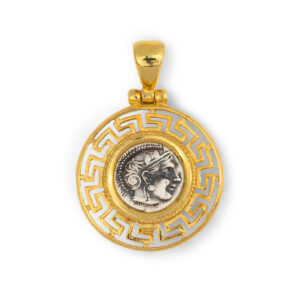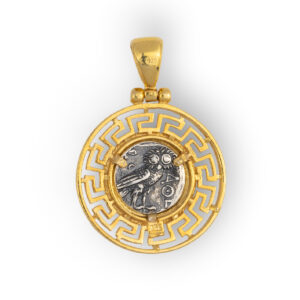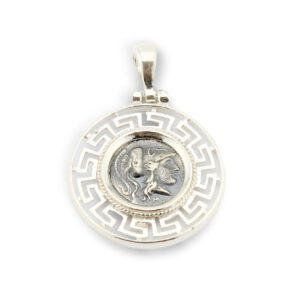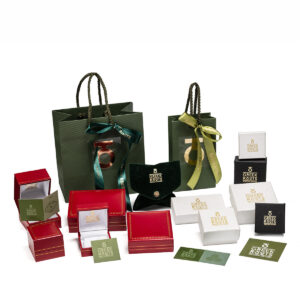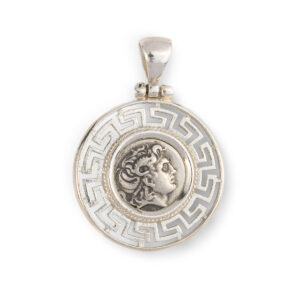Pendants
Medusa Pendant – 925 Sterling Silver
One of the most popular ancient Greek coins illustrate Medusa on the one side and the Knossos labyrinth on the other.
Medusa, in Greek mythology, the most famous of the monster figures known as Gorgons, generally described as a winged female with living venomous snakes in place of hair; unlike the Gorgons, she was sometimes represented as very beautiful. According to Hesiod and Aeschylus, she lived and died on an island named Sarpedon, somewhere near Cisthene. Medusa was beheaded by the hero Perseus, who thereafter used her head, which retained its ability to turn onlookers to stone, as a weapon until he gave it to the goddess Athena to place on her shield. according to another account; Perseus buried it in the marketplace of Argos. The Labyrinth in ancient Greek was an elaborate, confusing structure designed and built by the legendary artificer Daedalus for King Minos of Crete at Knossos. Its function was to hold the Minotaur. the Minotaur is a mythical creature portrayed in Classical times with the head of a bull and the body of a man. The Minotaur was eventually killed by the Athenian hero Theseus. (wikipedia)
Black oxidized background.
Made of 925⁰ sterling silver.
Gold Plated Goddess Athena & Owl Coin Pendant
One of the most popular ancient Greek coins illustrates Athena’s head on one side and the wisdom owl on the other. In Greek mythology, Athena is the daughter of Zeus and the goddess of wisdom, handicraft, and warfare. The owl traditionally accompanies Athena. Because of such association, the owl has been used as a symbol of knowledge and wisdom.
Made in-house in 925⁰ sterling silver the perimeter is decorated with meander or the Greek key design.
Available in sterling silver.
Goddess Athena and Owl – Athenian silver tetradrachm Dracma was the currency used in Greece during several periods in its history. The tetradrachm was an Ancient Greek silver coin equivalent to fourdrachmae in Athens it replaced the earlier “heraldic” type of didrachms and it was in wide circulation from ca. 510 to ca. 38 BC. This coin belongs to the so-called “new style Athenian coins” minted between 166 and 64 B.C. and is considered one of the most popular ancient Greek coins which illustrate the portrait of Goddess Athena on the one side and the wisdom owl on the other. Athena is an ancient Greek goddess associated with wisdom, handicraft, and warfare. Athena was regarded as the patron and protectress of various cities across Greece, particularly the city of Athens, from which she most likely received her name. She’s usually shown in art wearing a helmet and holding a spear. Her major symbols include owls, olive trees, and snakes. Her temples were located atop the fortified Acropolis in the central part of the city. The Parthenon on the Athenian Acropolis is dedicated to her, along with numerous other temples and monuments. Her main festival in Athens was the Panathenaia, which was celebrated in midsummer and was the most important festival on the Athenian calendar. In the classical Olympian pantheon, Athena was regarded as the favorite daughter of Zeus. The owl traditionally accompanies Athena. Because of such association, the owl has been used as a symbol of knowledge and wisdom. The inscriptions contain the city’s “national” appellation (“ΑΘΕ», i.e. “of the Athenians”).
Goddess Athena Pendant – Sterling Silver Gold Plated
Ancient Greek coins with the face of ancient Greek goddess Athena or Alexander The Great. In Greek mythology, Athena is the daughter of Zeus and the goddess of wisdom, handicraft, and warfare.
Handcrafted 925 sterling silver coin pendant.
Goddess Athena Coin Pendant – 925 Sterling Silver
This Ancient Greek coin represents Athena Chalinitis on the front side and the inscription “ΑΛΕΞΑΝΔΡΟΥ” on the back side
Made of 925 sterling silver.
Handmade item.
Athena – Stater of Corinth
This silver stater of Corinth depicting the head of Athena Chalinitis.
Alexander the Great Coin Pendant – Sterling Silver
Ancient Greek coin representing Alexander the Great on one side and King Lychimahos on the other.
Made of 925⁰ silver with the Greek key design known as meandros.
Handmade item
The chain shown is our Sterling Silver Cable Chain – Length 45 cm (not included).
Meandros design is a decorative border constructed from a continuous line, shaped into a repeated motif. Such a design is also called the Greek fret or Greek key design, although these are modern designations. On the one hand, the name “meander” recalls the twisting and turning path of the Meander River in Asia Minor, and on the other hand, as Karl Kerenyi pointed out, “the meander is the figure of a labyrinth in linear form” the meaning is that there is no beginning and no end in some cases so it becomes the symbol of long life and eternity.
Goddess Athena Pendant – Sterling Silver
One of the most popular ancient Greek coins illustrates Athena’s head on one side and the wisdom owl on the other.
Made in-house in 925⁰ sterling silver and the perimeter is decorated with meander or the Greek key design.
Available in gold plated.
The chain shown is our 925 Sterling Silver Oxidized Wheat Chain (not included)
Goddess Athena and Owl – Athenian silver tetradrachm
Dracma was the currency used in Greece during several periods in its history. The tetradrachm was an Ancient Greek silver coin equivalent to fourdrachmae in Athens it replaced the earlier “heraldic” type of didrachms and it was in wide circulation from ca. 510 to ca. 38 BC. This coin belongs to the so-called “new style Athenian coins” minted between 166 and 64 B.C. and is considered one of the most popular ancient Greek coins which illustrate the portrait of Goddess Athena on the one side and the wisdom owl on the other. Athena is an ancient Greek goddess associated with wisdom, handicraft, and warfare. Athena was regarded as the patron and protectress of various cities across Greece, particularly the city of Athens, from which she most likely received her name. She’s usually shown in art wearing a helmet and holding a spear. Her major symbols include owls, olive trees, and snakes. Her temples were located atop the fortified Acropolis in the central part of the city. The Parthenon on the Athenian Acropolis is dedicated to her, along with numerous other temples and monuments. Her main festival in Athens was the Panathenaia, which was celebrated in midsummer and was the most important festival on the Athenian calendar. In the classical Olympian pantheon, Athena was regarded as the favorite daughter of Zeus. The owl traditionally accompanies Athena. Because of such association, the owl has been used as a symbol of knowledge and wisdom. The inscriptions contain the city’s “national” appellation (“ΑΘΕ», i.e. “of the Athenians”).

